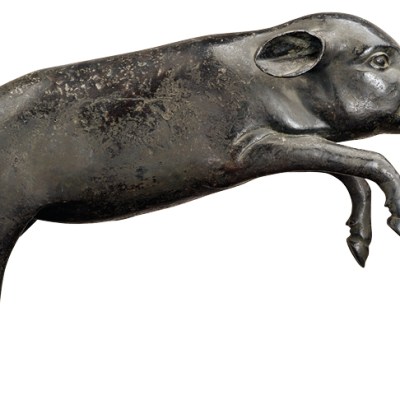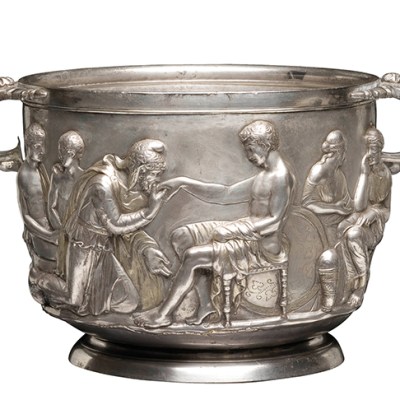From the January 2021 issue of Apollo. Preview and subscribe here.
The story of the Torlonia is the story of a family rising from humble origins in the Auvergne to the upper echelons of the Roman aristocracy in just three generations. Their ascent is captured by the golden rosebuds and rising comets on their coat of arms. The family’s inestimable wealth, based largely on banking and real estate, is the stuff of a literary genre of its own: Jules Verne’s fantastical voyage From the Earth to the Moon is financed by Torlonia money, while Stendhal thought the family’s parties worthy of an emperor. The interiors of numerous churches, the balance sheets of countless charities and the careers of a host of artists, among them Canova, Thorvaldsen and Ingres, owe much to Torlonia patronage.
The established aristocracy could merely look on as their inherited fortunes shrank, while Marino (1725–85), Giovanni Raimondo (1754–1829) and Alessandro (1800–86) Torlonia navigated, with what was perceived as suspicious effortlessness, the major political and economic upheavals of their day. Contemporary pamphlets containing accounts of their opportunism and insatiable appetite for making profit fill many shelves. In Ignazio Silone’s novel Fontamara (1933), the peasant Michele explains the order of the universe as he sees it: ‘At the head of everything, there is God, Lord of Heaven. Everyone knows this. Then comes Prince Torlonia, Lord of the Earth. Then come the guards of the prince. Then come the dogs of the guards of the prince. Then, nothing. Then, again nothing. Then, again nothing. Then come the cafoni [the peasant class]. And that’s the end of it.’
It was Alessandro who, in 1875, established what would become known as the Museo Torlonia, accessible to the public until 1976 and easily the most important private collection of Roman antiquities in existence. The more than 600 pieces include all types of sculpture, from portrait busts to vases and sarcophagi. Many of these, such as a celebrated bronze statue of the Roman general Germanicus, were discovered during excavations on the family’s own estates. Another large part was acquired from some of the most distinguished collections in Rome, which the Torlonia, lacking ancient roots, consciously sought to emulate. Chief among them are those of Vincenzo Giustiniani, Bartolomeo Cavaceppi and Alessandro Albani, the contents of whose celebrated villa on the Via Salaria, purchased by the Torlonia in 1866, had been catalogued by Johann Joachim Winckelmann. The catalogues compiled by Pietro Ercole and his nephew Carlo Ludovico Visconti a century later are landmarks of scholarship as well as of sculpture photography. They have until recently been the primary sources of information on the Torlonia marbles.
Girl from Vulci, c. 50–40 BC. Torlonia Collection, Rome. Photo: Lorenzo De Masi; © Fondazione Torlonia

The true scope of the collection – one of the most notoriously exclusive in the Eternal City – has been the subject of much speculation, with some sources supposing a total of as many as 2,000 pieces. Following decades of unsuccessful efforts to transfer the collection to a public museum, heated discussions were triggered by widely publicised yet ultimately thwarted attempts on the part of the heirs of the late Alessandro Torlonia (d. 2017) to sell a large portion of it to the Getty Museum, including many hitherto uncatalogued sculptures.
The Torlonia collection is matched in range, quality and provenance by only the Vatican and Capitoline Museums. It is at the latter, more specifically at the Villa Caffarelli, that, as a result of largely secretive arrangements between the Fondazione Torlonia and the Italian government – spearheaded by culture minister Dario Franceschini – a selection of 92 pieces is now finally on display. Formerly the residence of a page of Emperor Charles V, the villa later served as a cultural hub of the German community until Mussolini confiscated the site to establish a museum bearing his name. Annexed to the Capitoline Museums in 2005, the villa was completely renovated for the occasion of this much anticipated exhibition, which was designed by the Milan studio of David Chipperfield. Admirers of the English architect’s sensitive restoration of the Neues Museum in Berlin, which houses a significant part of that city’s collection of antiquities, are likely to be disappointed by the ubiquity of dark grey bricks used for floors, plinths and platforms. Intended to evoke the remains of the Temple of Jupiter Optimus Maximus, also on the Capitoline Hill, the final result is arguably closer to a modern crematorium or swimming pool. Subdivided into a myriad of small spaces of varying shapes and dimensions, this labyrinthine parcours is ill-suited to containing the often monumental exhibits, which demand generous spacing.
The sense of being overwhelmed, brought about by the sheer quantity and concentration of rarely seen masterpieces, may well have been part of the strategy. Upon entering, the viewer comes face to face with a chorus of ancient Roman portrait busts, arranged on a three-tiered platform that recalls the display of their counterparts in the Capitoline’s permanent collection at the Palazzo Nuovo. Gathered nearby are two of the most famous works from the collection: the so-called Girl from Vulci, a breathtaking bust of a young woman carved in white marble and named after the city in which it was found. Although commonly dated to the first century BC, the bust has a timeless elegance that connects its subject to Nefertiti as much as to early portraits by Picasso. Placed on an unfortunately high plinth nearby is the Old Man of Otricoli, a pinnacle of sculptural realism, a hallmark of the portraiture of the following century.
Old Man of Otricoli, c. 50 BC. Torlonia Collection, Rome. Photo: Lorenzo De Masi; © Fondazione Torlonia

Here and in many other instances, notably with a fascinating ex voto bas-relief, the uninitiated visitor would benefit from insights into the original function, lost polychromy or iconography of the works in front of them, otherwise afforded only to those willing to shell out €39 for the catalogue on top of their entrance fee. That the interpretation of the marbles was no priority for curators Salvatore Settis and Carlo Gasparri is further evidenced by the absence of descriptive labels, while room panels merely elucidate the provenance of individual objects, a preoccupation unlikely to be shared by non-specialists.
The almost complete absence of information on restoration practices across the centuries is particularly surprising, not least given that several pieces passed through the workshop of the sculptor and restorer Bartolomeo Cavaceppi, and in light of the fascinating written contributions offered by Vincenzo Giustiniani. The fact that sculptors of the calibre of Gian Lorenzo Bernini started out in the restoration of ancient sculptures, as seen in the statue of a resting goat formerly owned by Giustiniani, could have been explored further. In the case of the two Marsyas figures nearby, it would have been helpful to add that their identification is largely based on the way in which their constitutive fragments have been recomposed by later sculptors, a practice encapsulated in an influential essay by Jennifer Montagu from 1989 titled ‘The Influence of the Baroque on Classical Antiquity’.
Room 7 of ‘The Torlonia Marbles’ at the Villa Caffarelli, Rome, displaying sculptures that came from the Giustiniani collection. Photo: Oliver Astrologo; © Fondazione Torlonia/Electa/Bulgari

Visitors familiar with the Torlonia marbles might suspect that their state of preservation guided the selection of the 92 pieces here, preferential treatment having been accorded to recently restored works. Sponsored by the Italian luxury label Bulgari, these restorations deserve to be discussed critically, for it could be argued that the complete removal of their century-old patina by thorough cleaning has deprived some sculptures of their aura. It is to be hoped that the collection will be given a more generous spatial and interpretative context when it travels to the United States or returns to Rome, possibly to the Palazzo Silvestri-Rivaldi, which is about to be renovated at the expense of the Italian government. In the meantime, the pandemic permitting, visitors to Rome have the rare opportunity to follow in the footsteps of numerous illustrious predecessors in admiring the industry with which the Torlonia have been collecting and preserving masterpieces over the past two centuries.
‘The Torlonia Marbles: Collecting Masterpieces’ is at the Capitoline Museums, Rome, until 29 June.
From the January 2021 issue of Apollo. Preview and subscribe here.



